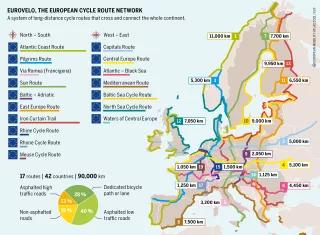
Tourism is a major economic sector in Europe. But its negative impacts on the environment and local communities raise concerns. Sustainable travel is growing, yet Covid-19 could change everything.

Over the past few decades, tourism trips have become an increasingly important part of the lives of many Europeans. In 2017, 62 percent of the adult EU population made at least one tourism trip. Of the 1.2 billion trips that were taken that year, the majority were domestic, representing three quarters of the trips, with 20 percent to other EU Member States, leaving around six percent to destinations outside the Union.
Europe is the world’s most popular tourism destination and the continent’s tourism industry has enjoyed sustained growth. It is currently estimated that it contributes 10.3 percent of the EU’s GDP and employs over 27 million people.
In recent years, however, there has been increasing awareness of some of the challenges that have been created by this growth, particularly in terms of the negative impact that it can have on the environment and communities located in or close to the most popular touristic destinations. The concept of ‘overtourism’ has become a growing concern. Venice received more than 25 million international tourists in 2018, in a city with a population of less than 55,000. Popular tourist destinations are therefore increasingly focusing on ‘destination management’ rather than ‘destination promotion’. This is likely to take on even greater significance following the Covid-19 pandemic.
One of the main challenges when dealing with increasing numbers of tourists is how they move around. Tourism goes hand in hand with travel, even for domestic tourism trips. Unfortunately, the growth of the tourism industry in recent years has largely been built on unsustainable travel patterns. To take the example of air travel, between 2012 and 2017 tourist air travel grew by 15 percent. While the airline industry is keen to stress that air travel is now cheaper, safer and open to more people than ever before, there is no hiding its negative impact on the environment. This coincided with the overall environmental impacts from aviation increasing 10 percent for carbon dioxide, 12 percent for nitrogen oxide and 14 percent for noise between 2014 and 2019.
To change that, EU citizens are going to have to adapt how they go on holiday. Sustainable forms of tourism have always existed and in recent years, more of these options have started to make their way onto the market. It is promising that consumers are increasingly taking sustainability into consideration when choosing their holidays. In a recent study, 50 percent of the respondents stated that deciding an environmentally-friendly holiday option was important to them, with the figure rising to 56 percent for those born in the mid-to-late 1990s. This is reflected in the growing numbers of people taking more sustainable holidays. For example, approximately 5.5 million Germans went on a cycling tourism trip in 2018, representing 8 percent of the total population.
Coinciding with this growing recognition of the importance of sustainability, the Covid-19 pandemic may prove to be a pivotal moment for the tourism sector. The travel patterns that have developed in recent decades have been abruptly halted and at the time of writing, it is not clear when they will be able to return to anything like the situation prior to the pandemic. This disruption is forcing millions of Europeans to rethink their holiday plans and to seriously consider their options for travelling to planned destinations.
Encouragingly, the tourism sector also appears to acknowledge that this is a watershed moment and is not simply attempting to restore ‘business as usual’, despite the devastating short-term economic impact. As the EU Tourism Manifesto Alliance, the voice of the European travel and tourism sector, noted in its recent statement to the European Commission: “This crisis creates a downturn, but also an opportunity for change, for a new beginning in tourism across Europe.”
It is a positive development that tourism trips are increasingly open to a larger percentage of the European population, helping to break down barriers and enabling people to better understand each other. Tourism can continue to make a significant contribution to the European economy while preserving and enhancing the continent’s valuable cultural heritage and natural environments that are so attractive to visitors. However, all stakeholders – the industry, public authorities, transport operators, tourists and the local communities – need to develop clear recommendations and guidance for the consumers. That should start with the journey to the destination.
Sources for data and graphics: World Tourism Organization, International tourism and Covid-19, https://bit.ly/3jxCQhi; EuroVelo, https://bit.ly/35CGlhi; European Parliament, Research for TRAN Committee – From Responsible Best Practices to Sustainable Tourism Development, https://bit.ly/2HLdakf


